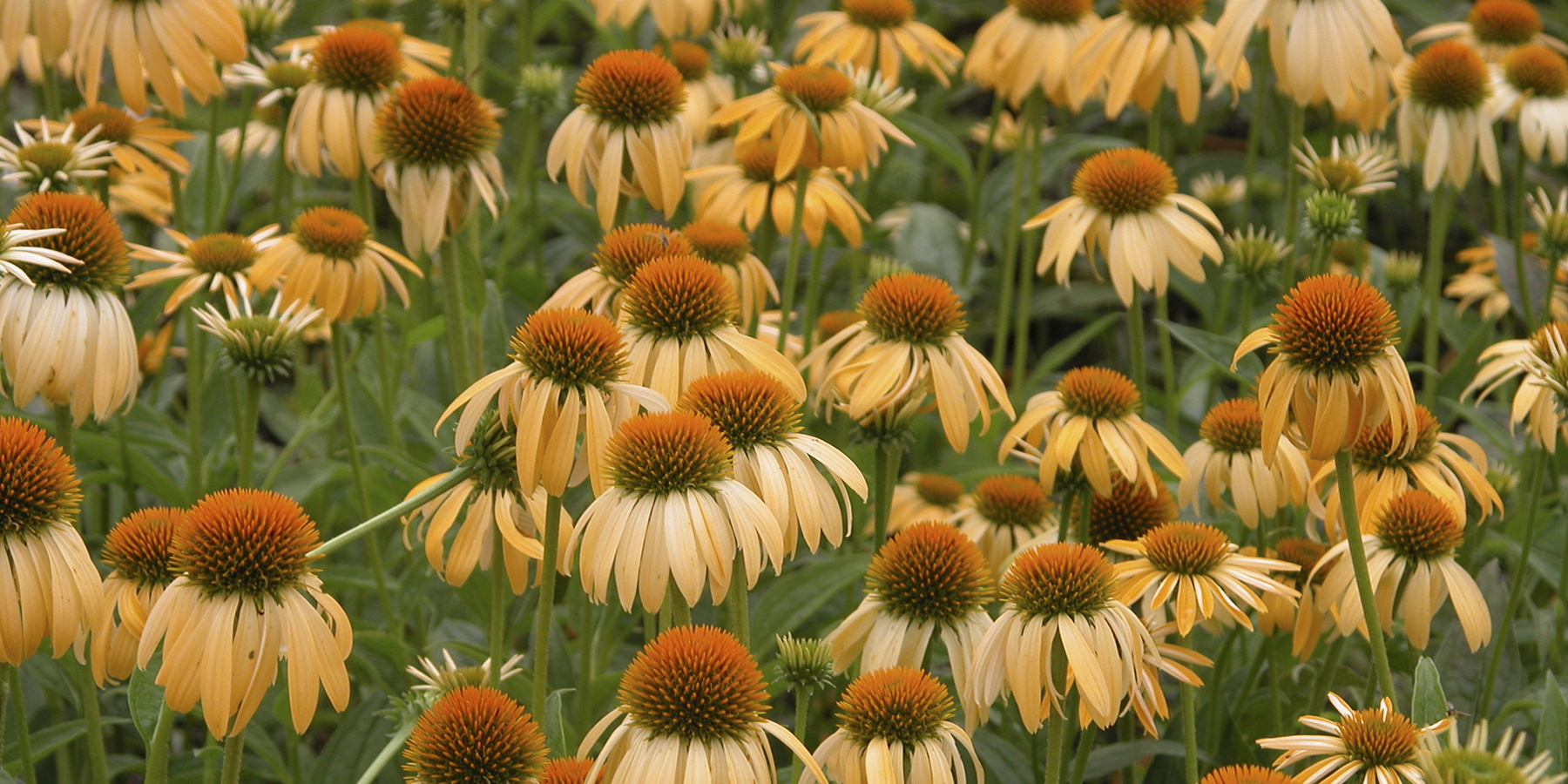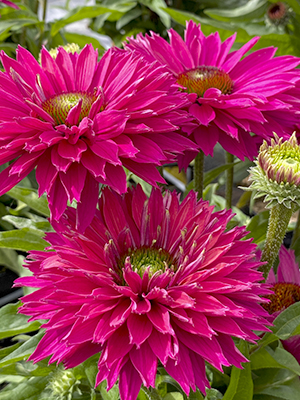The Echinacea Renaissance

Modern Echinacea cultivars feel differently today than the popular varieties released even a decade ago: more flowers, bigger blooms, lusher crowns, longer lifespans, and so forth. These aren’t the Echinaceas you remember, but the ones shipping now, the popular ones that move to the top of the sales charts and stay there. These changes didn’t happen by accident but as a reaction to a series of key events in the Echinacea timeline. The Renaissance affects what you grow and why, and it still pushes new forms and new production techniques forward even in 2023.
The Echinacea Renaissance built on earlier efforts. The First Wave occurred when the trade cleaned up the native prairie plant for commercial production. Adaptation always occurs first, taking something nice like purpurea and making it nicer. Think ‘Magnus’ (the tall one) or ‘White Swan’ (the white one) or ‘Kim’s Knee High’ (the short one)..

'Orange Meadowbrite' changed the Echinacea world
The Rock ’n’ Roll Era
Like it did with Elvis, the world changed with the release of ‘Orange Meadowbrite’ by Jim Ault at Chicagoland Grows. It wasn’t pink. “You can do that?” was the response among breeders. The Echinacea flower became the riffs and licks from the Saul Brothers’ Big Sky series or a stream of hits like ‘Tomato Soup’ and ‘Mac ’n’ Cheese’ out of Terra Nova. A market bending explosion of colors marked the era.
Meanwhile, Europeans took the American native in their own direction, due in part to the significant support of their floral industry. Darwin pulled ‘Razzmatazz’, generally regarded as the first pompom double, from the Netherlands. Improvements like ‘Pink Double Delight’ and ‘Hot Papaya’ followed. Even today, the floral influence on Echinaceas from Europe is still strong. Look at the bedhead Funky series or the bald cones of the Drumstick series for florists who pluck off the petals (yes, they do that over there).

Big Sky 'Harvest Moon' was a best seller in the Rock 'n' Roll era
The Blowback
Back in America, the sales of single-color Echinaceas started to stall. Wait, what? Echinaceas can be uncool? Apparently, yes. Garden centers, liner producers, and breeders all started to hear complaints about short lifespans, winter kill, color fading, short bloom windows, and a litany of demerits that turned gardeners toward other choices.
You could see the problem in the rapid churn of the sales charts. A variety would storm to number one, only to plateau and sag a few years later. Another flashy one would take off then fizzle quickly. At the time, we thought Echinacea was a fad-driven category. In hindsight, sales showed us underlying problems, but we didn’t pick up on this until the whole category sagged.

Europe's 'Razzmatazz' is generally considered to be the first Echinacea double in commercial production
The Renaissance Age
Our modern Echinacea grew out of this crisis. Breeders pulled back and reassessed their strategies, especially within the dominant innovators. Features that define a good Echinacea today, such as heavy flower count, extended bloom window, long lifespan, and slow-to-fade flowers come from their “whole plant” approach toward selection and improvement. Rather than walking through a field of samples and picking out cool flower tops, breeders judged plants by their ability to survive winter, create multiple growing points, and pass through TC production successfully.
Take a look at a modern series like Kismet or Sombrero, and lift up the flowers. The difference you see is controlled by large sets of criteria at the breeding houses: winter survivability, multiple growing points, first year flowering, beefy crowns, well-formed roots, and sturdy stems. One benefit already visible? Popular varieties stay popular longer. This stability wasn’t the case in the past, and it is a blessing for planners and buyers for the future.

Bred by Terra Nova, Kismets are known for their extra large blooms.
Seed Pushes Forward
Seed gives Echinacea the ability to reach into decor and landscape markets where plants are presented without cultivar names. TC struggles here but seed competes because cost expectations and crop performance are set by the annuals.
PanAmerican/Kieft Seed dominated the market for about a decade with Cheyenne Spirit and the Pow Wow Series, noted as consistent, vibrant, and affordable. Once Cheyenne Spirit flourished in autumn decor, seed suppliers responded. Two years ago PanAmerican added three Artisan solid colors, and last year rival Benary moved their PollyNation series of five solids from a limited trial to full availability.
 |
 |
 |
| Artisan 'Red Ombre' | Artisan 'Yellow' | Artisan 'Soft Orange' |
The Promise of URC
Then there is ‘Panama Red’, a short Echinacea from Danziger shipped as cuttings. Conventional wisdom says you can’t do this, but they finished trial production at Monrovia and James Greenhouses and moved to the general market this year. URC holds the promise of TC-like consistency, shipped at a price closer to seed. Danziger knows a thing or two about URC, so they have ramped up their stock availability to meet this year’s anticipated demand.

I know a number of growers who plan to give 'Panama Red' a spin.
The New Wave
Going forward, I don’t see evidence of innovation slowing. Take a look at the pallida-style versions. Best typified by ‘Pretty Parasols’ and the Mama series, the ring petals drape downward, giving the blooms a distinctive arrowhead look. This is where you will find the most successful bicolors as well.
A newer trend is the dahlia-like styling of the double ring petals, found in certain Sunseekers colors like ‘Sweet Fuchsia’, ’Golden Sun’, or ‘Rainbow’. Each has a standard cone surrounded by double or triple rings of outside petals.
 |
 |
| 'Fiery Meadow Mama' | 'Pretty Parasols' |
 |
 |
 |
| Sunseekers 'Golden Sun' | Sunseekers 'Mineola' | Sunseekers 'Sweet Fucshia' |
The Cognoscenti’s Pick
Ask pros to name the best cultivar and one name keeps popping up: ‘Sensation Pink’. You might expect a flashier variety but a single pink is the jazz standard of the business and ‘Sensation Pink’ plays it well.
Mount Cuba summed it up when ‘Sensation Pink’ ran a perfect score in their highly-regarded multi-year Echinacea trial. “An absolutely striking cultivar with a luminous neon-pink bloom, it is a little bit better in every way,” reported the trial director. “Beautiful dark stems, nice upright plant, no disease issues, didn’t flop over, ticked all the checkboxes”.
This is full circle Renaissance breeding, taking all that modern goodness back home to where it all started—a simple prairie flower.

Notice the dark stems underneath Marco van Noort's 'Sensation Pink'.
Popular Articles








